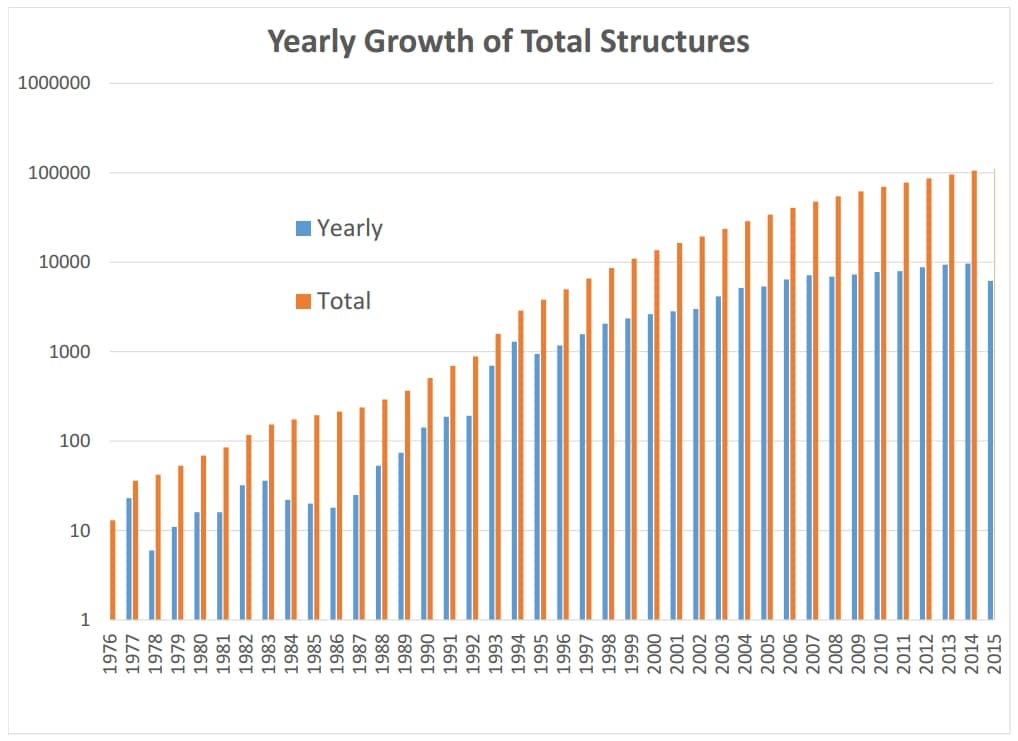August 26, 2015
Want 3D Vision? Protein Data Bank (PDB) Ligand Structures are now LIVE in CDD Vault® (Part 1 of 2)
Want 3D Vision? PDB ligand structures are now LIVE in CDD Vault®
Guest blog from CDD Advocate: Dr. Dale Cameron Part 1 of 2 The very best medicinal chemists can think in 3D about the compounds they design (both in the absence and presence of a molecular target). They appreciate that 3D structures are dynamic, dependent on their environment and important for optimizing candidate properties. Ligand-target co-crystallization data can augment traditional structure activity relationship analyses. Now you can collectively consider your proprietary data within CDD Vault® using the latest ligand structures from the Protein Data Bank (PDB). The amount of publicly available structural information has continued to grow rapidly (Figure 1) 1, and while the RCSB does a fantastic job hosting this data, more can be done for small molecule drug discovery analyses (and idea generation) where the data is available in a ligand centric format (such as CDD Vault). Furthermore, the structures can be compared with your own data or other public data sets such as the GPCR ligands from the PDSP, Kinase ligands from ChemBL and GSK PKIS sets, or simply versus similar compounds that can be purchased via numerous vendors. See the complete set of public data CDD have made available, including key structural information for ligands from the PDB public dataset within CDD Vault here. Figure 1: Yearly Growth of Total Structures at the PDB. Ligand structures are now included within CDD Vault as live links and are fully searchable. Commercial users of the CDD Vault can do queries and analysis on these important compounds with crystal structures together with their own data. CDD has captured key information about the ligands and their protein (or other) complexes, extracted directly from the PDB, and made it available at your fingertips. All the ligands from the PDB are collated in one place, so you can find the summary information with links directly to the PDB pages on structures of interest. Try it out today, and if you have suggestions for other key data that could be stored CDD Vault, please let us know because the value goes up as a function of the number of engaged collaborators using the software. CDD works hard to collate the most useful information for the scientific community, even though naturally, the majority of data always remains secure and private by default. In part 2, we'll share examples of how to use this amazing new data set within CDD Vault with some helpful screenshots to get you started -
click here to subscribe to our blog and receive part 2. 1. Berman, H. M. Nucleic Acids Res. 2000, 28, 235–242.
Figure 1: Yearly Growth of Total Structures at the PDB. Ligand structures are now included within CDD Vault as live links and are fully searchable. Commercial users of the CDD Vault can do queries and analysis on these important compounds with crystal structures together with their own data. CDD has captured key information about the ligands and their protein (or other) complexes, extracted directly from the PDB, and made it available at your fingertips. All the ligands from the PDB are collated in one place, so you can find the summary information with links directly to the PDB pages on structures of interest. Try it out today, and if you have suggestions for other key data that could be stored CDD Vault, please let us know because the value goes up as a function of the number of engaged collaborators using the software. CDD works hard to collate the most useful information for the scientific community, even though naturally, the majority of data always remains secure and private by default. In part 2, we'll share examples of how to use this amazing new data set within CDD Vault with some helpful screenshots to get you started -
click here to subscribe to our blog and receive part 2. 1. Berman, H. M. Nucleic Acids Res. 2000, 28, 235–242.
This blog is authored by members of the CDD Vault community. CDD Vault is a hosted drug discovery informatics platform that securely manages both private and external biological and chemical data. It provides core functionality including chemical registration, structure activity relationship , chemical inventory, and electronic lab notebook capabilities! CDD Vault: Drug Discovery Informatics your whole project team will embrace!
Other posts you might be interested in
View All Posts
Events
2 min
April 22, 2024
Recorded Presentations: CDD 20th Anniversary User Group Meeting
Read More
CDD Blog
9 min
April 19, 2024
Drug Discovery Industry Roundup with Barry Bunin — April 19, 2024
Read More
CDD Blog
2 min
April 19, 2024
CDD Appoints Yasushi Hamagashira as Head of Sales and Marketing for Japan
Read More


